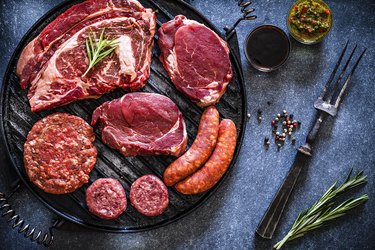
Have you recently donated blood, experienced heavy menstrual bleeding or sustained blood loss from injury or surgery? If so, you'll have to rebuild your blood supply to ensure that all the cells in your body receive adequate life-sustaining nutrients. Failure to do so can lead to a condition known as anemia, which can be remedied, in part, through diet.
Anemia Due to Excessive Bleeding
Video of the Day
According to the American College of Physicians, the technical definition of anemia is "decreased red blood cell mass." The World Health Organization diagnoses anemia on the basis of your level of hemoglobin (grams/deciliters), an oxygen-carrying protein in red blood cells. The hemoglobin values needed for an anemia diagnosis are:
Video of the Day
- People assigned male at birth: less than 13.0 grams/deciliters
- People assigned female at birth: less than 12.0 grams/deciliters
- Pregnant people: less than 11.0 grams/deciliters
Anemia due to excessive bleeding, the most common cause of anemia, is the result of the loss of red blood cells outpacing production of new red blood cells. So careful attention must be paid not only to anemia but to blood loss.
Blood Loss Symptoms
According to Dr. Evan M. Braunstein, a hematologist from the Johns Hopkins School of Medicine, blood loss symptoms depend on the amount and speed of blood loss, usually classified as acute or chronic. Acute blood loss, taking less than several hours, can be fatal if only one-third of blood volume is lost and can cause dizziness upon standing, a common symptom. Chronic blood loss, taking weeks or more, may cause only fatigue or no symptoms when up to two-thirds of blood volume is lost.
Additional blood loss symptoms depend on the location of the bleeding. Bleeding from the upper gastrointestinal tract can cause black, tarry stools, and bleeding from the urinary system can cause red or brown urine. More generally, anemia symptoms can make you feel tired, cold, dizzy and irritable, and you may experience headaches or shortness of breath.
Building Blood After Blood Loss
Acute blood loss is a medical emergency requiring immediate attention, and both acute and chronic blood loss require clinical supervision. The source of the bleeding must be stopped and, if blood loss is rapid, intravenous fluids and a blood transfusion may be required. With chronic blood loss, the body may rebuild its own blood supply without the need for transfusion. This is often the case after donating blood.
To rebuild blood for blood loss recovery, the American Red Cross suggests drinking an extra four glasses (8 ounces each) of nonalcoholic liquids and eating healthy meals that include iron-rich foods. This fluid consumption is in addition to the normal Dietary Reference Intake, which, according to Medline Plus, is between 91 and 125 fluid ounces (2.7 to 3.7 liters) of water per day for adults, although individual needs depend on weight, age and activity level, as well as any existing medical conditions. There are no specific recommendations for amount of water to drink.
Foods to Rebuild Blood Supply
In addition to a healthy diet that includes an adequate intake of fluids, electrolytes and macro-nutrients, micronutrients like iron and B vitamins, which includes B2, folate (B9) and riboflavin (B6), are essential to rebuilding the body's supply of red blood cells. To increase production of red blood cells, the National Institutes of Health (NIH) recommends:
- Eating foods rich in iron and B vitamins like red meat (especially beef and liver), poultry, fish, beans, tofu, dark-green, leafy vegetables and iron-fortified cereals and breads.
- Eating fruits and vegetables that are high in vitamin C, like oranges and lemons, to help with iron absorption.
- Consulting a doctor about iron supplements.
- Getting checked every year or two if you're a woman of childbearing age who has heavy menstrual periods or a previous diagnosis of anemia.
Supplement With Iron
The NIH indicates that, according to new studies, lower-dose multivitamins or over-the-counter iron supplements (18 to 27 milligrams) are as effective as higher-dose prescription iron (38 to 65 milligrams elemental iron) when taken for 60 days to replenish the iron depleted from blood loss and are associated with fewer side effects.
The NIH also recommends ferrous gluconate over ferrous sulfate due to the occurrence of fewer side effects. Iron supplements may cause constipation and can be taken with vitamin C-rich drinks like orange juice to limit this side effect by increasing iron absorption in the intestines.
- American College of Physicians: Blood Loss Anemia
- World Health Organization: Haemoglobin Concentrations for the Diagnosis of Anaemia and Assessment of Severity
- Merck Manual: Anemia Due to Excessive Bleeding
- American Red Cross: Frequently Asked Questions
- MedlinePlus: Water in Diet
- National Institutes of Health: Avoiding Anemia
- National Institutes of Health: Iron and Blood Donation
Is this an emergency? If you are experiencing serious medical symptoms, please see the National Library of Medicine’s list of signs you need emergency medical attention or call 911.